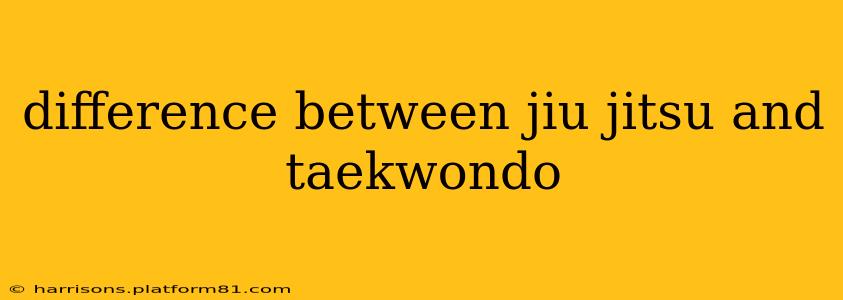Jiu-Jitsu and Taekwondo, while both martial arts, differ significantly in their philosophies, techniques, and applications. Understanding these differences is crucial for anyone considering either discipline. This comprehensive comparison will explore the key distinctions, helping you determine which martial art aligns best with your goals and preferences.
What is Jiu-Jitsu?
Jiu-Jitsu, particularly Brazilian Jiu-Jitsu (BJJ), focuses on grappling and ground fighting. It emphasizes taking the fight to the ground, utilizing techniques like submissions (chokeholds, joint locks) and positional dominance to subdue an opponent. Striking is largely absent in traditional BJJ, with the focus instead on controlling and neutralizing an opponent's movement on the mat. BJJ is renowned for its effectiveness in real-world self-defense scenarios, especially against larger, stronger opponents.
What is Taekwondo?
Taekwondo is a Korean martial art emphasizing striking techniques using the hands and feet. It's characterized by powerful kicks, fast punches, and dynamic movements. While some forms of Taekwondo incorporate grappling and self-defense techniques, the core of the discipline remains focused on delivering impactful strikes from a distance. Taekwondo is often praised for its fitness benefits, developing speed, agility, flexibility, and discipline.
Key Differences Between Jiu-Jitsu and Taekwondo
Here's a breakdown of the core differences between these two distinct martial arts:
Fighting Style:
- Jiu-Jitsu: Primarily ground fighting, emphasizing grappling, submissions, and positional control.
- Taekwondo: Primarily striking, emphasizing powerful kicks, fast punches, and dynamic movements.
Range of Combat:
- Jiu-Jitsu: Close-range combat; the fight typically ends up on the ground.
- Taekwondo: Long- to mid-range combat; utilizes distance to deliver strikes effectively.
Primary Techniques:
- Jiu-Jitsu: Chokes, joint locks, takedowns, sweeps, guard retention, escapes.
- Taekwondo: Kicks (various types, including spinning kicks), punches, blocks, and some basic self-defense grappling.
Physical Fitness Focus:
- Jiu-Jitsu: Strength, endurance, flexibility, and strategic thinking. Develops overall body strength and conditioning.
- Taekwondo: Speed, agility, flexibility, balance, and cardiovascular endurance. Focuses on leg strength and power.
Self-Defense Application:
- Jiu-Jitsu: Highly effective in close-quarters combat and ground fighting scenarios. Ideal for neutralizing a stronger opponent.
- Taekwondo: Effective for maintaining distance and delivering powerful strikes, but less effective in close-range grappling situations.
Competitive Aspects:
- Jiu-Jitsu: Competitions involve submission grappling, with points awarded for takedowns and control, the ultimate goal being a submission.
- Taekwondo: Competitions focus on points awarded for strikes landed, with techniques judged on accuracy, power, and speed.
Which Martial Art is Right for You?
The choice between Jiu-Jitsu and Taekwondo depends on your individual goals and preferences. Consider these factors:
- Your preferred fighting style: Do you prefer close-range grappling or long-range striking?
- Your physical attributes and strengths: Are you stronger, more flexible, or faster?
- Your self-defense needs: What types of self-defense scenarios are you most concerned about?
- Your competitive interests: Are you interested in competing in tournaments?
Frequently Asked Questions (FAQs)
Is Jiu-Jitsu better for self-defense than Taekwondo?
Both are effective in self-defense, but their effectiveness depends on the specific scenario. Jiu-Jitsu excels in close-quarters combat and ground fighting, while Taekwondo is better at maintaining distance and delivering powerful strikes. The "better" martial art depends entirely on the context.
Can you learn both Jiu-Jitsu and Taekwondo?
Absolutely! Many martial artists train in multiple disciplines to gain a well-rounded skill set. The combination of Jiu-Jitsu and Taekwondo would provide a very comprehensive self-defense system.
Which martial art is more physically demanding?
Both are demanding in their own ways. Jiu-Jitsu involves intense grappling and strength training, while Taekwondo requires significant cardiovascular fitness, flexibility, and leg strength.
Which martial art is better for fitness?
Both are excellent for fitness. Taekwondo often results in more significant cardiovascular improvements, while Jiu-Jitsu builds more overall body strength and endurance.
Ultimately, the best way to decide between Jiu-Jitsu and Taekwondo is to try both! Attend introductory classes in both disciplines to get a feel for the training style, techniques, and overall atmosphere before making a decision.
